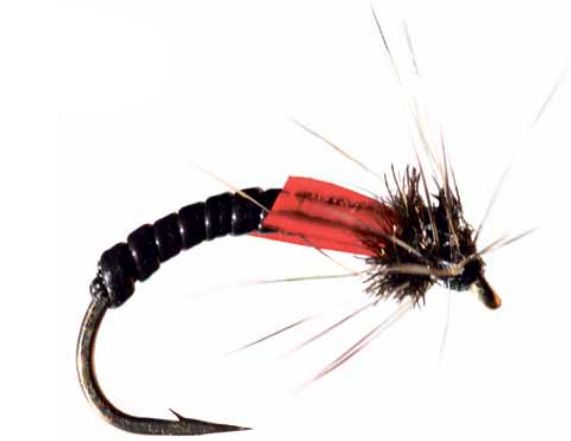 Presented from Issue 95
Presented from Issue 95
I do not want to sound all flowery and fluffy, but some of my recent fishing on Tasmania’s superb streams where the little birds flutter about at rod’s length and the caddis are like snowflakes hovering in the clouds all excites me. What must it do to the trout? There are, of course, many insects on these small streams, the main one at this time of year is the mayfly. But the eager trout are mostly happy to take almost anything you may present to them on the shallow bubbly waters. A little Red Tag size fourteen or a Deer Hair Caddis work well. Where the waters have some depth, my personal choice is a small wet, a nymph, beetle or stick caddis.
A new one I’ve tried on the streams is a little buzzer. A buzzer, or chironomid nymph, is a popular fish food. There are many patterns which are quite simple to tie. My preference is a fly with some red material. It does not seem to matter where the red is worn on the fly, it may be a small flash around the head area or a full body but as most will know, red is a very popular trout attractor. This fly may be fished as a single fly cast upstream and let drift naturally, or tied in under a dry fly so the angler has a double chance. A dry can also work as a strike indicator, with this method working well on lakes in a wind lane — fish it on the edge of the smooth and rippled water. More often than not, the fish will take the buzzer. One thing to remember when tying this fly in as a dropper is to note the depth of the water, especially on streams. The dropper needs to be just short of the bottom.
 Buzzer Hook:
Buzzer Hook:
- Size 12-14 buzzer hook
- Thread: Black
- Body: Black swannundaze
- Wing or gill: Two red goose biots
- Thorax: Small peacock herl
- Hackle or legs: One grizzle feather
Method
- Take thread well round the bend of the hook.
- Tie swannundaze and bring thread forward. Stop well back from the eye.
- Bring swannundaze forward with nice even turns to the thread. Tie down firmly and cut away any excess.
- Tie one red good biot on each side of the body and cut the points off and any excess biot material.
- Place in the peacock herl and form a nice little head. Cut away excess herl.
- With the thread, tie the grizzle feather. Make only one turn as it needs to look like legs, not a neatly tied hackle. Cut away excess feather.
- Whip finish, cut thread away and place a small drop of varnish on the whip finish.
Jan Spencer




